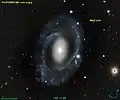NGC 210
NGC 210 is a barred spiral galaxy located roughly 67 million light-years from the Solar System in the constellation Cetus. It was discovered on October 3, 1785 by William Herschel and later added to the New General Catalogue.
| NGC 210 | |
|---|---|
 NGC 210 by Adam Block/Mount Lemmon SkyCenter | |
| Observation data (J2000.0 epoch) | |
| Constellation | Cetus[1] |
| Right ascension | 00h 40m 35.0s |
| Declination | −13° 52′ 20″ |
| Redshift | 0.005457 |
| Heliocentric radial velocity | 1636 km/s (1016.5 mi/s)[2] |
| Distance | 20.5 ± 1.5 Mpc (67 ± 5 Mly.)[3] |
| Apparent magnitude (V) | 11 |
| Characteristics | |
| Type | SAB(s)b[2] or Sb D[4] |
| Apparent size (V) | 5.012' x 3.09' [5] |
| Other designations | |
| MCG -02-02-081, 2MASX J00403502-1352220, 2MASXi J0040349-135221, IRAS 00380-1408, IRAS F00380-1408, AKARI J0040346-135214, CGS 126, 6dF J0040350-135222, LDCE 0041, HDCE 0030, USGC S024, AGC 400333, GSC 5271 00477, HIPASS J0040-13, PGC 2437 | |
Physical properties
It appears to be in loose association with NGC 157 and NGC 131. It is noted for its peculiar arms, which appear to be in the process of becoming a ring galaxy. They also have several apparently dense regions throughout them. The inner part of the galaxy appears to be lenticular, with a dust lane in it. The nucleus of the galaxy appears much brighter than the rest of it, suggesting an active galactic nucleus.
Satellites
In the image at the right, 2MASX J00403079-1353088 is the edge-on galaxy directly below the brightest star in the image. It is possibly a satellite of NGC 210, but without a redshift to determine its distance, it could just as possibly be completely unrelated to NGC 210.
Supernovae
15.9 magnitude SN 1954R was observed on September 7 in the outer edge of NGC 210's left arm and is likely associated with the galaxy.[6]
Gallery
 2MASS Near-infrared image of NGC 210
2MASS Near-infrared image of NGC 210 PanSTARRS image of NGC 210
PanSTARRS image of NGC 210
References
- "NGC 210 - DeepSkyPedia :: Astronomy". Retrieved 2013-12-02.
- "NED search results for NGC 0210". Retrieved 2013-12-02.
- An object's distance from Earth can be determined using Hubble's law: v=Ho is Hubble's constant (70±5 (km/s)/Mpc). The relative uncertainty Δd/d divided by the distance is equal to the sum of the relative uncertainties of the velocity and v=Ho
- "NGC 210". SIMBAD. Centre de données astronomiques de Strasbourg. Retrieved 2013-12-02.
- "NGC 210 - Galaxy - WIKISKY". Retrieved 2013-12-02.
- "SN 1954R from NED". Retrieved 2013-12-02.